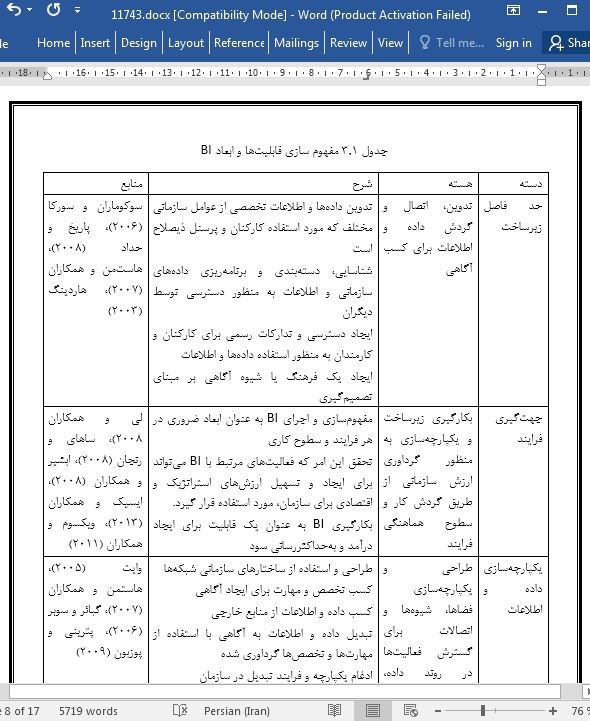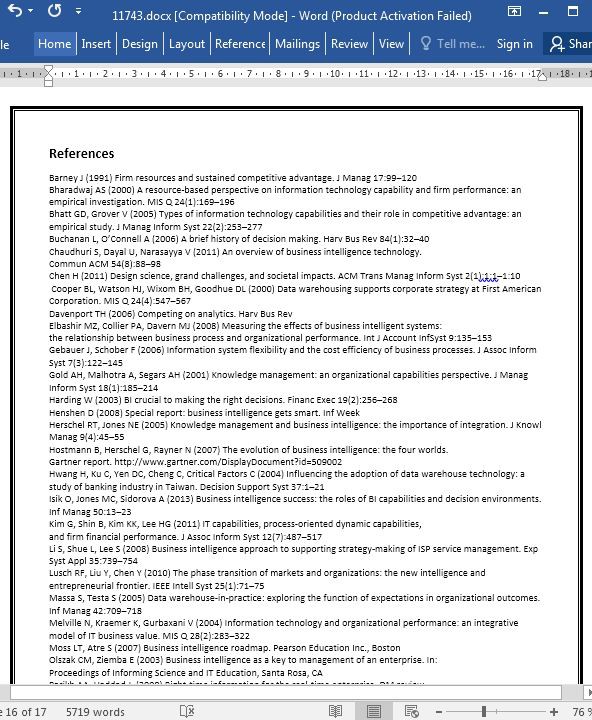
قابلیت های هوش تجاری
چکیده
هوش تجاری (BI) به عنوان یک حوزه مهم تخصصی در ارتباط با ارزش پیشنهادی شرکتها است. شرکتها به دنبال تعدیل و اصلاح BI به عنوان یک قابلیت ذاتی برای ایجاد ارزش (یا ارزشسازی) هستند. با در نظر گرفتن حوزه سیستمهای سازمانی، BI دارای گسترهای فراتر از یک ابزار یا محصول برای مد نظر قرار دادن تعدادی از قابلیتها است. ما تمرکزمان را روی قابلیتها و پژوهشهای قبلی مرتبط با BI، به منظور افشای قابلیتهای بلقوهای قرار میدهیم که BI برای یک سازمان ایجاد میکند. یک طبقهبندی سهدستهای در اینجا پیشنهاد میگردد که عبارتند از: قابلیتهای زیرساختی نوآورانه BI، قابلیت پردازش BI، و قابلیت یکپارچهسازی BI. ما به بحث در مورد خصوصیات این سه قابلیت BI میپردازیم تا این چشمانداز را ارائه کنیم که این قابلیتها چگونه به سازمانها کمک میکند. این دستهبندی به تصمیمگیرندگان کمک خواهد کرد تا تصمیمات اگاهانهای را در مورد چگونگی پیاده سازی موثر BI در سازمانشان به منظور بهبود عملکرد، اتخاذ نمایند.
3.1 مقدمه
هوش تجاری (BI)، اشارهای به تکنیکها، فناوریها، سیستمها، شیوهها، روشها و کاربردهایی دارد که به تجزیه و تحلیل دادههای کسب و کار مهم میپردازد تا به یک شرکت کمک کند که درک بهتری از کسب و کار و بازار پیدا کرده و تصمیمات بهموقعی در مورد کسب وکار بگیرد (راماکریشان و همکاران. 2012) . BI (هوش تجاری)، کمکی به تبدیل مقدار زیادی از دادههای حاصل از منابع مختلف به اطلاعات معنادار، به منظور پشتیبانی از تصمیمات میکند. تخمین زده شده است که سرمایهگذاری BI از 54.5 میلیارد دلار در سال 2012 به 96.9 میلیارد دلار در سال 2016 رسیده است (تابیت 2013) .
3.4 استفاده از دستهبندی
به دنبال ظهور پدیده هوش تجاری، سازمانها نسبتا تحت تاثیر زودگذر این ابزار قرار میگیرند. عملا، از آنجایی که شایعات در حول و هوش BI بسیار زیاد است، جنبهها و چشماندازهای BI در بین شرکتها متفاوت بوده، و دارای مفاهیم، تعارف و کاربرهای مختلف است. در عین حال که حذف این تفاوتها مار مشکلی است، ادغام جنبههای BI در مدلهای کلی میتواند مطمئنا یک روش مفیدی باشد و هدف این فصل، ایجاد چنین دیدگاه جامعی در مورد یکپارچهسازی BI در یک سازمان است، اگرچه همراه با جانبداری در مسیر جنبههای قابلیتی آن است.مد نظر قرار دادن این جنبههای قابلیتی، کمکی به تاکید بر این واقعیت میکند که BI صرفا در عمل و در مباحث علمی یک روند زودگذر یا شایعه نیست، بلکه میتواند در روند انباشت عملکرد سازمانی بالاتر، کمککننده باشد. در واقع، مفاهیم نظری و مدل توسعه یافته در این فصل در مسیر ایجاد روابط بین ابعاد مختلف قابلیتهای BI، طرحهای یکپارچه، و تاثیر این ابعاد روی عملکرد سازمانی، قرار میگیرد.
Abstract
Business intelligence (BI) is emerging as a critical area of expertise for firms’ value proposition. Firms are trying to leverage BI as an inherent capability to create value. Considering an organizational systems view, BI extends beyond a tool or artifact to include a number of capabilities. We draw on IT capabilities and prior research on BI to uncover potential capabilities that BI bestows to an organization. A three category BI capability classification is suggested: BI innovation infrastructure capability, BI process capability and BI integration capability. We discuss the attributes of these three BI capabilities to provide insights into how the capabilities help organizations. This taxonomy will help decision-makers take informed decisions on how to effectively implement BI within their organization to improve performance.
3.1 Introduction
Business Intelligence (BI) is referred to the techniques, technologies, systems, practices, methodologies, and applications that analyze critical business data to help an enterprise better understand its business and market and make timely business decisions (Ramakrishnan et al. 2012). BI helps transform large amount of data from disparate sources into meaningful information to support decision making. BI investment is estimated to grow from $54.5 billion in the year 2012 to $96.9 billion in the year 2016 (Tabbitt 2013). BI is being used in almost all industry sectors and is a top priority for organizations (Isik et al. 2013).
3.4 Using the Taxonomy
With the advent of business intelligence, organizations are somewhat moved by a ‘fad’ effect around this tool. In practice, while the buzz around BI is very high, BI perspectives and viewpoints vary across firms, with differing concepts, definitions and applications. While eliminating the differences would be a herculean task, integrating BI perspectives into holistic models can certainly be a fruitful approach. The intention of this chapter is to provide such a holistic view around BI integration in an organization, albeit with a bias towards a capability perspective. Taking the capabilities perspective helps to highlight the fact the BI is ‘not just a fad’ or buzz’ in the practice and academic discourse, but it can be helpful in garnering higher organizational performance. Indeed, the theoretical concepts and model developed in this chapter are oriented towards establishing the relationships between different dimensions of BI capabilities, their integrated schema, and the influence of these dimensions on organizational performance.
چکیده
3.1 مقدمه
3.2 هوش تجاری (BI) چیست؟
3.3 دستهبندی قابلیتهای BI
3.4 استفاده از دستهبندی
بیوگرافی
منابع
Abstract
3.1 Introduction
3.2 What is BI?
3.3 Classification of BI Capabilities
3.4 Using the Taxonomy
Biographies
References
- اصل مقاله انگلیسی با فرمت ورد (word) با قابلیت ویرایش
- ترجمه فارسی مقاله با فرمت ورد (word) با قابلیت ویرایش، بدون آرم سایت ای ترجمه
- ترجمه فارسی مقاله با فرمت pdf، بدون آرم سایت ای ترجمه



